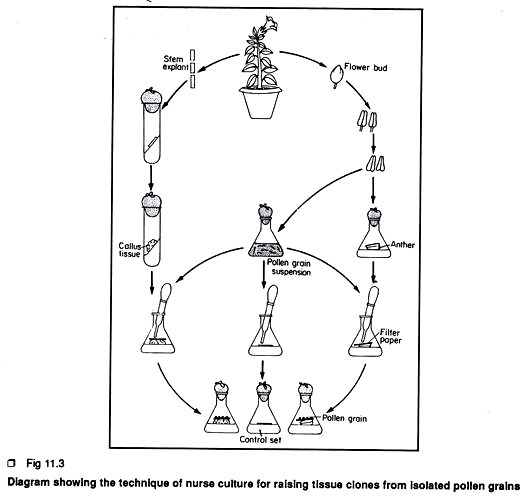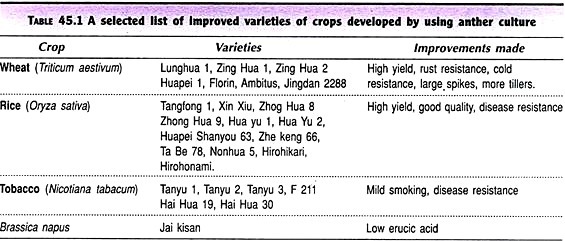Experiment to Observe Diversity of Plants!
Contents
Experiment:
Objective:
To study the characteristics of Spirogyra, Agaricus, Moss, Fern, Pinus (either with male or female cone) and an angiosperm plant.
Draw and give two identifying features of the groups they belong to.
Apparatus and materials required:
A slide of Spirogyra, specimen of Agaricus, moss, fern, Pinus with a male female cone, an angiosperm plant, like mustard, hand lens and a compound microscope.
Theory:
Diverse organisms have a wide range of sizes, structures, forms, shapes and distributions on the earth. There are more than 10 million organisms on the earth. About 1.7 million of them (1.2 million animals and 0.5 million plants) have been identified, scientifically named and classified.
Spirogyra (green algae):
Characteristics:
1. Spirogyra is a green alga having a filamentous, unbranched, multicellular and threadlike structure.
2. Each filament has a large number of rectangular (length being more than breadth) cells.
3. Each cell has two parts: the thick, two-layered cell wall (outer wall made up of pectin and the inner wall is cellulosic) and the protoplasm.
4. The filaments of Spirogyra are slimy to touch due to the dissolution of their outer pectin layer.
5. The cytoplasm has a large vacuole at the centre and 1-16 ribbon-shaped, spirally coiled chloroplasts. Each chloroplast has a number of small round bodies called pyrenoids.
6. A large nucleus is suspended in the centre of the cell by a number of cytoplasmic strands.
Characteristic features of the group:
1. The green algae Spirogyra belongs to the group Thallophyta. The members of this group have an undifferentiated body called thallus.
2. No vascular system is found in the members.
3. Algae are autotrophic, i.e., they synthesize food by photosynthesis as they have the chlorophyll pigments.
Agaricus (mushroom):
Characteristics:
1. Agaricus is a common, white, fleshy edible mushroom.
2. It grows in the rainy season on damp logs of wood, trunks of trees and decaying organic matter.
3. It is a saprophytic fungus.
4. The body is umbrella-shaped and is divided into a fleshy stalk, or stipe, and a fleshy pileus, or cap.
5. The pileus is dome-shaped, present at the top of stipe. The under surface of the pileus has many radiating strips called gills.

6. A membranous, ring-like structure called annulus is present on the stalk which covers the young basidiocarp.
7. The function of the basidiocarp is to produce and disperse spores.
Characteristic features of the group:
1. A mushroom is a fungus that belongs to the group Thallophyta.
2. The modes of nutrition in fungi are saprophytic or parasitic.
3. They do not possess chlorophyll, hence depend either on dead organic matter or on other living organisms for food.
Funaria (moss):
Characteristics:
1. Mosses are commonly found growing in tufts on moist and shady walls, damp soil and on tree trunks.
2. The main plant body is a gametophyte (haploid) which is green, erect (1-3 cm high) and sparsely branched.
3. The plant body is differentiated into root like structures called rhizoids, axis, or stem and spirally arranged leaves.
4. The rhizoids are branched and multicellular which fix the plant to the soil and absorb water and minerals.
5. The plant is monoecious or dioecious, i.e., bear both male and female sex organs on the same plant.
6. The mature plant bears sporophyte which consists of foot, seta and capsule for asexual reproduction.
Identifying features of the group:
1. Mosses belong to Bryophyta.
2. Proper root and shoot systems are absent. Vascular tissues are absent in this group.
3. Rhizoids present in this group function as roots.
Dryopteris (fern):
Characteristics
1. Dryopteris is commonly found in shady and moist areas in tropical, subtropical and warm, temperate regions.
2. The plant body is a sporophyte (diploid) which is differentiated into roots, rhizome (underground stem) and leaves.
3. The primary root is short-lived. It is replaced by adventitious roots which grow from the rhizome.
4. The rhizome represents the modified stem. It is a creeping structure and its surface is covered with leaf bases and numerous thin brown hair called ramenta.
5. The leaves are large and bipinnately compound. The entire leaf is called a frond. It has a rigid, scaly petiole elongated to form a rachis bearing two rows of leaflets. Young leaves show circinate vernation (coiled inwards like a spring).
6. The lower (ventral) surface of mature leaves bear spore-producing structures called sori. Such sori-bearing leaves are called sporophyll.
7. Each sorus has many saclike sporangia (spore-bearing structures), which produce spores.
Identifying features of the group:
1. Ferns belong to Pteridophyta.
2. The plant body is differentiated into root and shoots systems.
3. Vascular system is present in the members of this group.
Pinus:
Characteristics:
1. Pinus is commonly found on temperate and tropical hills.
2. The adult plant is a tall, evergreen tree with widespread branches giving a typical pyramidal shape.
3. The plant body is differentiated into tap root, stem and leaves.
4. The stem is thick, cylindrical and bears two types of branches—long shoots, or branches of unlimited growth and dwarf shoots, or branches of limited growth.
5. The leaves are of two types (dimorphic)—scale leaves which are non-photosynthetic, found at the base of dwarf shoot and foliage leaves which are needle-like, green, photosynthetic, and found on the dwarf shoot.
6. The male and female reproductive parts in the form of male and female cones are present on the same plant, i.e., the plant is monoecious.
Male cone (staminate strobilus):
1. The male cones are present in clusters (15-140) on long branches.
2. These are small dark brown, compact, oval structures which develop earlier than the female cones.
3. Each male cone has a centrally located cone axis with many microsporophylls (space-producing structures) arranged spirally on it.
4. Each microsporophyll bears two microsporangia, or pollen sac, on its lower surface.
5. The microsporangia release winged-pollen grains which are carried by the wind to ovules.
Female cone (ovulate strobilus):
1. The female cones are born in groups of 2-4 at the tips of long branches.
2. They are maroon-coloured, compact and bigger in size than the male cones.
3. Each female cone consists of a central cone axis covered with spirally arranged megasporophylls.
4. Megasporangia in the form of two naked sessile ovules are present on the dorsal surface of each megasporophyll.
5. The female cones take 3 years to mature. The first-year cones are very small and greenish in colour. The second-year cones are larger and woody with compact sporophylls which get separated during the third year due to elongation of the cone axis.
Identifying features of the group:
1. Pinus is a Gymnosperm.
2. The plant body has root and shoot systems with vascular tissues, but flowers are absent.
3. The members of this group bear naked seeds on the scales of cones.
A dicotyledonous Angiosperm (mustard):
Characteristics:
1. The plant is an annual herb.
2. The plant body consists of the vascular shoot and root systems.
3. The root is a tap root.
4. The shoot system consists of stem, leaves, flowers and fruits.
5. The stem is green, erect, herbaceous, branched, solid and smooth, bearing prominent nodes and internodes.
6. The leaves are sessile, alternate and dorsiventral with lobed margin.
7. The flowers are yellow, tetramerous (4 petals and 4 sepals) and bisexual. All the four whorls of a flower, i.e., calyx, corolla, androecium (male) and gynoecium (female) are present.
8. After fertilization ovary of the flower develops into a fruit and the ovules present inside the ovary develop into seeds. The seeds are used for extracting mustard oil.
Identifying features of the group:
1. The angiospermic plants have well-developed root system and shoot system.
2. The plants bear flowers, fruits and seeds.
3. These plants are either monocotyledonous (seeds with one cotyledon) or dicotyledonous (seeds with two cotyledons). Monocots have leaves with a scattered arrangement of vascular bundles. Dicots have reticulate venation in leaves and their vascular bundles are arranged in ring.




